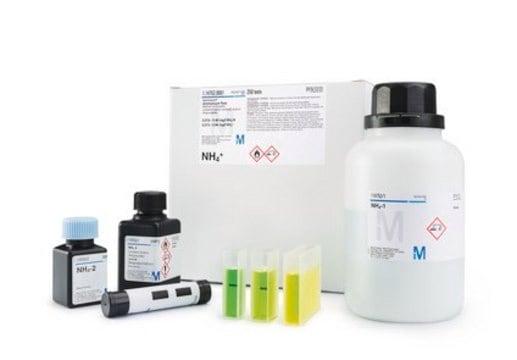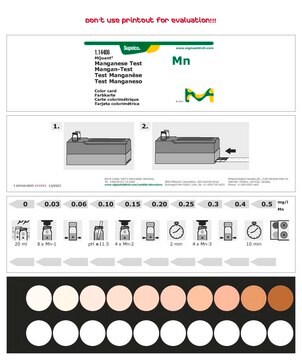1.00816
Manganese Test, photometric
photometric, 0.10-5.00 mg/L (Mn), Spectroquant®
About This Item
Recommended Products
product name
Manganese Cell Test, photometric, 0.10-5.00 mg/L (Mn), Spectroquant®
product line
Spectroquant®
Quality Level
usage
sufficient for 25 tests
specific analyte(s)
manganese
measuring range
0.10-5.00 mg/L (Mn)
technique(s)
photometry: suitable
compatibility
for use with Spectroquant® Move 100
for use with Spectroquant® Nova 60 A
for use with Spectroquant® Prove 100
for use with Spectroquant® Prove 300
for use with Spectroquant® Prove 600
detection method
photometric (Formaldioxime)
storage temp.
15-25°C
General description
The method is analogous to DIN 38406-2.
This Spectroquant® Manganese Cell Test allows the accurate quantification of the manganese(II) ions content in aqueous samples.
Method applied: In alkaline solution manganese(II) ions react with an oxime to form a red-brown complex which is determined photometrically.
The Spectroquant®Cell Tests come with prefilled 16 mm round cells and all the required reagents to perform the analysis according to the instruction leaflet provided.
All Spectroquant® Cell and Reagent Test Kits are equipped with the unique Live ID (2D barcode) which allows seamless method recognition and contains essential information such as lot number, expiry date, and automatic calibration updates.
Application
- Small-Molecule Fluorescent Probes for Binding- and Activity-Based Sensing of Redox-Active Biological Metals.: This review discusses the development of small-molecule fluorescent probes for detecting redox-active metals, including manganese, in biological systems. These probes enable precise analytical measurements and are essential in understanding metal ion homeostasis and signaling in cells. The manganese cell test provides valuable insights into redox biology and metal interactions (Grover et al., 2024).
- A Ten-Minute Bioassay to Test Metal Toxicity with the Freshwater Flagellate Euglena agilis.: This study introduces a rapid bioassay for assessing metal toxicity using Euglena agilis. The manganese cell test is a crucial component of this bioassay, providing a quick and reliable method for evaluating manganese toxicity in freshwater environments (Choi et al., 2022).
- A manganese (II) complex tethered with S-benzyldithiocarbazate Schiff base: Synthesis, characterization, in-vitro therapeutic activity and protein interaction studies.: This research focuses on synthesizing and characterizing a manganese (II) complex, examining its therapeutic potential and interactions with proteins. The manganese cell test plays a vital role in analyzing the complex′s biochemical properties and efficacy (Kongot et al., 2020).
- [New materials suitable for implantation--preparation for implants].: This article explores new materials for medical implants, emphasizing the importance of biocompatibility and durability. The manganese cell test is used to evaluate the interaction between manganese-based materials and biological tissues, ensuring their safety and effectiveness for implantation (Adam et al., 2003).
Legal Information
signalword
Danger
Hazard Classifications
Acute Tox. 3 Oral - Aquatic Acute 1 - Aquatic Chronic 2 - Carc. 1B - Eye Dam. 1 - Met. Corr. 1 - Muta. 2 - Skin Corr. 1B - Skin Sens. 1 - STOT RE 2 Oral - STOT SE 3
target_organs
Respiratory system, spleen
Storage Class
6.1C - Combustible, acute toxic Cat.3 / toxic compounds or compounds which causing chronic effects
wgk_germany
WGK 3
Certificates of Analysis (COA)
Search for Certificates of Analysis (COA) by entering the products Lot/Batch Number. Lot and Batch Numbers can be found on a product’s label following the words ‘Lot’ or ‘Batch’.
Already Own This Product?
Find documentation for the products that you have recently purchased in the Document Library.
Protocols
Photometric determination subsequent to acid mineralisation
Our team of scientists has experience in all areas of research including Life Science, Material Science, Chemical Synthesis, Chromatography, Analytical and many others.
Contact Technical Service





